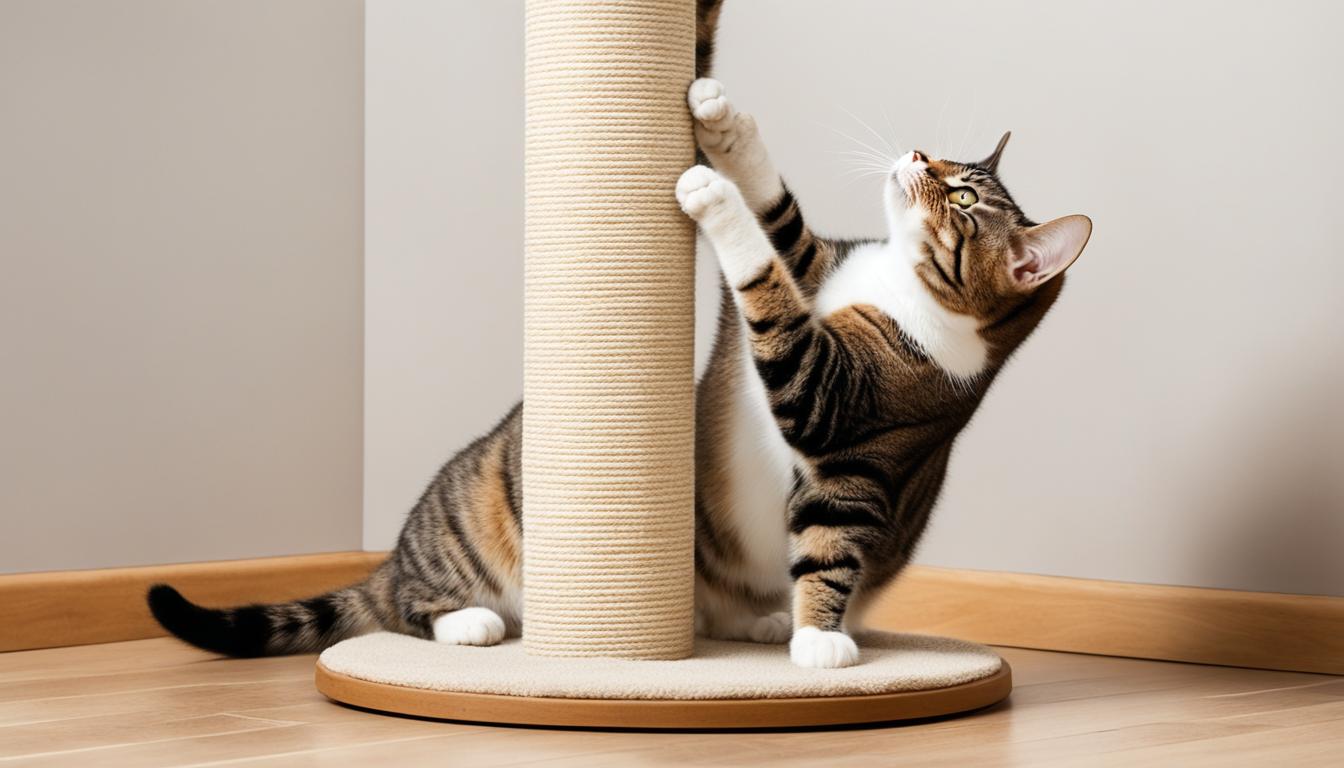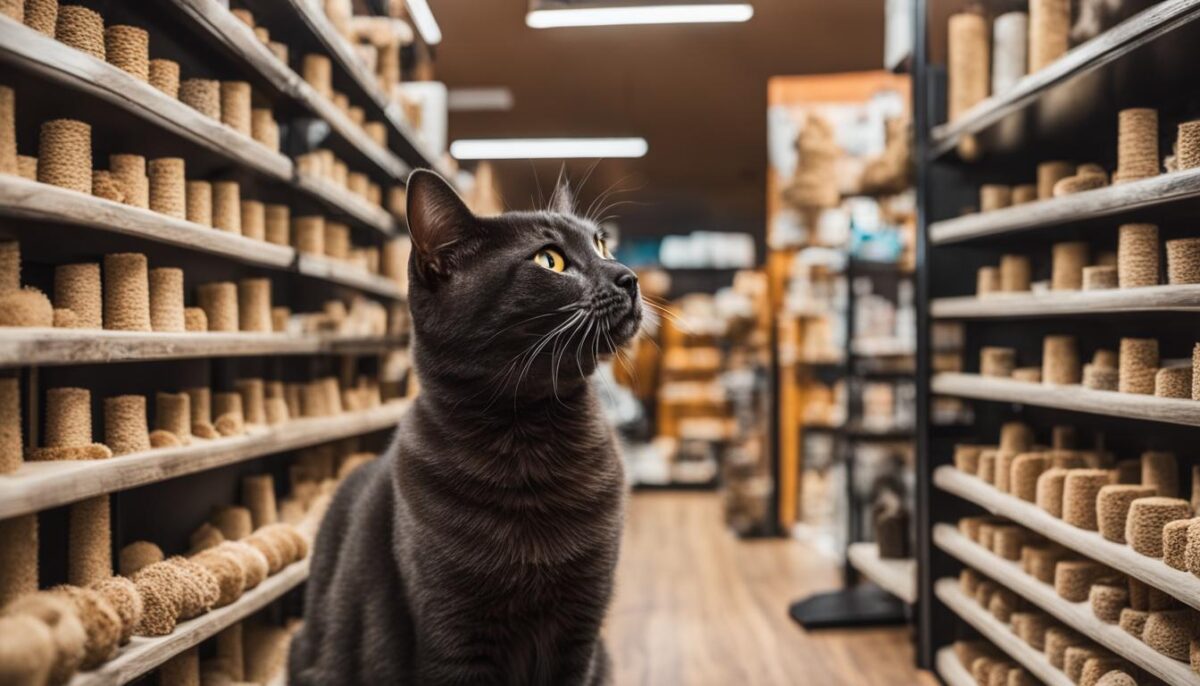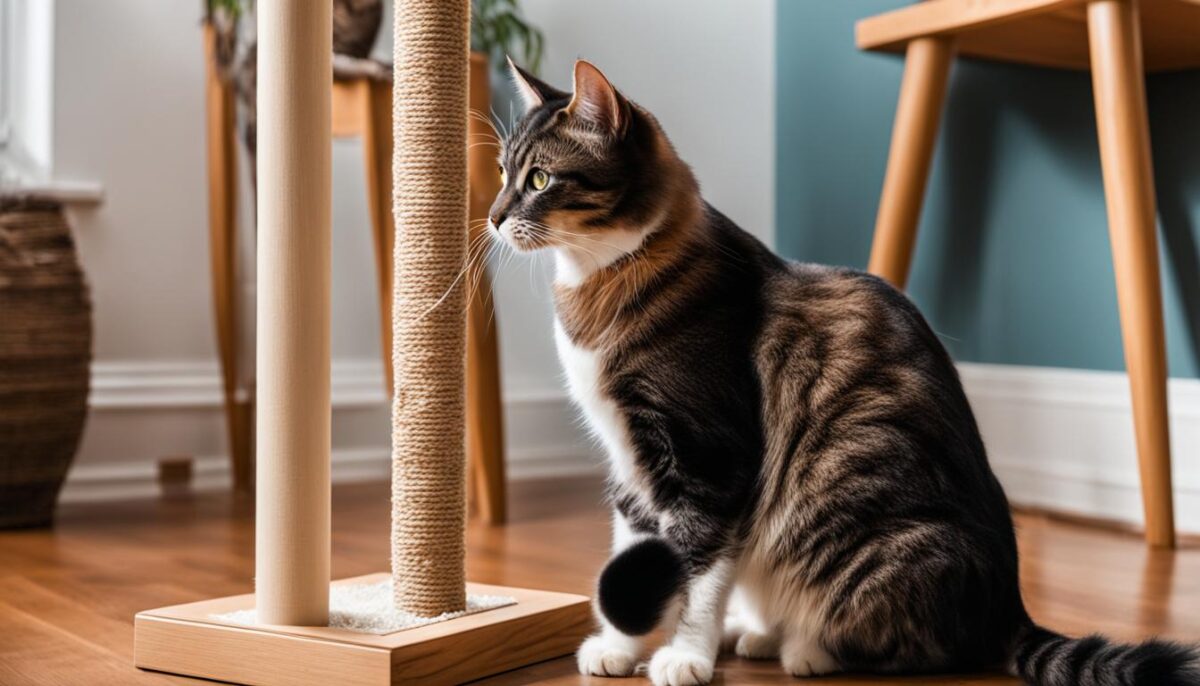Is your cat leaving marks on your furniture? Are you looking for ways to stop your cat from scratching your favorite couch? You’re not alone! With the right cat scratching post training, you can keep your furniture safe and make your furry friend happy. All it takes is a bit of know-how and positive reinforcement for cats.
First, find a good scratching post. Cats love to stretch and scratch. It’s how they say, “This is my place!” To help your cat use their post, put it where they spend a lot of time. If they like napping in the sunshine near a window, place the post there. Your cat will soon understand that the post is theirs to scratch—and not your sofa!
Key Takeaways
- Find a great scratching post for your cat.
- Place the post where your cat likes to hang out.
- Use positive ways to train your cat.
- Watch your cat scratch their post, not your furniture.
- Be patient and keep trying, and your cat will learn.
Understanding Your Cat’s Natural Behaviors
Have you ever wondered why your furry friend does what it does? Cats have their unique ways, and cat territory marking and feline behavior might seem mysterious, but they’re quite simple! Let’s dive into what makes them tick, especially when it comes to their love of scratching.
Why Cats Scratch as a Communication Tool
Believe it or not, when your cat scratches, it’s not just to sharpen their claws. It’s cat territory marking! This is your cat’s way of leaving a “this is mine” sign. They have scent glands on their paws, and when they scratch, they leave their smell, telling other cats, “Hey, I live here!”
The Need for Stretching: Muscle Maintenance
You know how good it feels to stretch when you wake up? Your cat feels the same way! Scratching is like yoga for cats. It helps them stretch their muscles and keep fit. This way, they can jump and run without any trouble. So, an effective cat scratching post placement is near where they nap!
Finding the Prime Real Estate for Cat Scratching Posts
Cats aren’t picky about where they scratch, but they do have their favorites. Your job is to find that perfect spot for a scratching post. Remember, they like to be where the family hangs out, and they love having options too! Try out different places in your home and see where they like to scratch the most.
| Favored Scratching Locations | Reasons for Preference | Tips for Scratching Post Placement |
|---|---|---|
| High-traffic Areas | Mark Territory | Place post where your family spends most of their time |
| Near Sleeping Quarters | Convenient for Stretching | Put post next to your cat’s bed or favorite nap spot |
| Specific Carpet Areas | Texture Preference | Move post to the carpet area they already scratch |
| Under the Bed or Closet | Privacy for Scratching | Consider placing a post in quieter areas of the home |
Now you know more about feline behavior, you can help your cat be happy and healthy. Find that perfect spot for a scratching post and watch your pal enjoy their personal gym and message board – it’s your way of saying, “I get you, kitty!”
How to Select the Perfect Scratching Post
When you’re choosing a scratching post for your furry friend, think about how cats love to stretch and scratch. It’s like their way of doing yoga! Let’s look at some things that make a durable cat scratching post.
Height Matters: Taller is Better
Did you know that cats love to reach high when they scratch? It helps them stretch their whole body! So, you want a scratching post that’s tall enough. Your cat should be able to stand on her back legs and reach up above her head with her front paws. It’s like when you reach up high to touch the sky!
Stability is Key to Avoid Wobbly Mishaps
Cats won’t use something that feels shaky or wobbly. A good scratching post must be really sturdy. Imagine if your playground slide moved around when you climbed on it – scary, right? That’s why the base of the scratching post should be wide and heavy enough so it won’t tip over.
The Attraction to Certain Textures
Cats are curious creatures and they have their favorite textures to scratch. Some like rope made from a plant called sisal – it’s tough and scratchy. Others might like softer materials like carpet or corrugated cardboard, which is kind of like wavy paper. It’s fun for them to discover which one they like best!
Cats have their own likes and dislikes, just like you and me. Trying out different cat scratcher materials helps you find the perfect match for your cat’s paws!
Remember, a happy cat is one that has a great place to scratch and stretch. Whether you have one cat or a bunch, they’ll all need a place to scratch. It keeps them healthy and stops them from scratching places they shouldn’t – like your couch! Look for a post that’s just right, and your feline friend will be purring with joy.
How to Train a Cat to Use a Scratching Post
Training cats to show love to their scratching posts instead of the couch can be easier than you think! Let’s sprinkle a little fun into their routine and save your furniture. The key is to make their scratching post the coolest place around. Encourage cat scratching post use with some of these simple tricks:
-
Start with a sprinkle of catnip on the post. It’s like magic dust that can make your kitties go wild for scratching in the right spot. Set that post up and watch them zoom in!
-
Got some toys? Great! Play around the post as if it’s a playground. This fun playtime can make your cat think, “This post is awesome!”
-
Is your cat a little unsure? No problem. Lay the post on its side to start. Sometimes, all they need is a little warm-up before the big show.
-
Treats can be a yummy “thank you” for using the post. When your kitty takes a scratch, give them a treat to say, “You’re doing great!”
Remember, no one likes a grumpy coach. So, avoid saying “No!” with a splash of water. We want happy cats, not scaredy-cats. Give it some time, lots of love, and those claws will be scratching in all the right places.
To prevent cat furniture damage, always cheer on the good stuff. High-fives for scratching the post, and calm redirects from the no-no places. Be their cheerleader, and they’ll learn that scratching the post is the best game in town!
Incorporating Play and Catnip for Positive Associations
Did you know that putting a little bit of catnip on a scratching post can make your kitty love it? Catnip, a plant that is safe for cats, can have funny effects on your furry friend, like making them roll around, purr, and play with excitement. Plus, when you use interactive cat toys with the catnip, it can help your cat learn to scratch where it’s okay and not on your favorite couch.
Some kittens don’t care about catnip at all, and that’s okay. But for cats that do like it, catnip can really help. It makes them happy and teaches them to scratch the post instead of your furniture, which is a part of positive cat training.
Interactive Toys: Beyond the Basics
When you play with your cat using a toy on a string, like a wand toy, you’re doing more than just having fun. You’re helping your cat get to know their new scratching post. Encourage them to reach and grab the toy, which will make them touch the post. This way, they’ll learn how it feels and that it’s a good place to scratch!
Catnip Can Be a Game Changer
Using catnip isn’t just about making your cat excited. It’s a smart way to help your cat learn new things, like using their scratching post. First, you might lay the post on the floor so it’s easy for them to use. After they’ve been scratching it for a few days, stand it up. They’ll remember how much fun it was and keep using it!
| Toy Type | Benefits for Cat Training | How to Use with Catnip |
|---|---|---|
| Wand Toy | Encourages chasing and grabbing, mimics the fun of hunting | Drag toy along the post to transfer catnip smell and entice play |
| Ball with Bell | Rolls unpredictably, engaging your cat’s attention | Roll over catnip covered post so it picks up the scent and interests your cat |
| Stuffed Mice | Perfect for batting, kicking, and carrying around | Rub catnip on the mouse and place near the post for a scent-filled surprise |
Remember, every cat is unique, like people, and not all cats will like the same toy or catnip. But with a little patience and lots of love, you can teach your cat good habits that will keep both of you happy at home!
Safeguarding Your Furniture Against Unwanted Scratching
Do you love your furry friend but not their little claw marks all over your sofa? If your cat thinks your furniture is better than a scratching post, we’ve got you covered! It’s time for some feline furniture protection. Here’s how you can stop unwanted cat scratching and keep your furniture looking nice.
First, let’s talk about tin foil. Yes, you heard that right—tin foil! Cats don’t like how it feels or sounds, so you can use it to cover the spots they scratch. Wrap the foil around the furniture and watch your cat’s reaction. They’ll probably give it a sniff and walk away.
If tin foil isn’t your style, try double-sided tape. It’s a little sticky and bothers your cat’s paws. Stick some on your furniture where your cat likes to scratch, and they’ll be eager to find a better place to stretch those claws.
Another great idea is using rugs or heavy throws. Make sure they are tucked in nice and tight. The thick fabric doesn’t feel good for scratching, and your cat will start looking for a new spot. That’s where the scratching post comes into play.
- Place the scratching post right next to the no-scratch zone. Your cat will notice the post and start using it instead of your couch or chair.
- Use catnip to make the new scratching spot more exciting. Sprinkle some on the post to draw your kitty’s attention.
- Rub the post with a bit of your cat’s scent by gently wiping a cloth on your cat and then on the post. This can make it feel familiar.
Every time your cat uses the scratching post instead of the furniture, give them a little treat or some extra love. This will teach them where it’s good to scratch. With a little time and patience, your cat will learn to keep their claws to the scratching post—saving your furniture and keeping you both happy!
Conclusion
Teaching your cat to use a scratching post can be a win for both of you. Sometimes you might need to move the post to a new spot where your cat loves to look out the window. This could get their attention and make them want to scratch the post instead of your couch. If your cat likes to watch birds or squirrels, putting the post near a window with a good view can really help.
Remember, finding cat scratching solutions that work can take some time. But it’s worth it! With a little bit of patience and lots of kind words, you can have successful cat post training. Your cat will be happy, too! Using these tips means they have their own special spot to scratch, keeping them busy and happy. When your cat is happy, they are a happy indoor cat, and this makes your home a peaceful place for everyone. So keep working with them, and soon they will love their scratching post.
All it takes is understanding what your cat likes, plus some encouragement and rewards, to make sure they stick to the post you’ve set up for them. It’s the best way to save your furniture and make sure your furry friend has a good time scratching safely. Good luck!
FAQ
How can I train my cat to use a scratching post instead of my furniture?
Start by placing the scratching post in a visible area close to where your cat sleeps or near the furniture they typically scratch. Use positive reinforcement for cats, such as treats and praise when they use the post, and sprinkle catnip to attract them. Be patient and consistent in redirecting their scratching to the post.
Why is my cat scratching furniture so much?
Cats scratch furniture for several reasons, including territory marking with visual cues and scents, stretching and maintaining muscle health, and because it’s a natural behavior. Understanding feline behavior can help you direct this activity to an appropriate location, like a cat scratching post.
Where is the best place to put a cat scratching post in my house?
The most effective cat scratching post placement is in areas where your cat spends a lot of time. This includes high-traffic zones, near their favorite sleeping spots, or by carpet areas they are already showing interest in scratching. Avoid secluded spots as they are less likely to be used for territory marking.
What qualities should I look for in a durable cat scratching post?
When choosing a scratching post, ensure it’s tall enough for your cat to stretch fully (reaching above their head), and that it’s stable to prevent any wobbly mishaps. Cats have different texture preferences, so consider a post made of natural rope, corrugated cardboard, or carpet to see what appeals to your pet.
Can playtime help encourage my cat to use a scratching post?
Absolutely! Interactive cat toys can help create positive associations with the scratching post. Engage your cat in play by using wand toys near the post and sprinkle catnip to add further enticement, especially if they are responsive to its effects.
How do I protect my furniture from unwanted cat scratching?
To deter your cat from scratching furniture, cover the targeted areas with a heavy blanket, tin foil, or double-sided tape. Position a scratching post nearby and encourage your cat to use it instead. Gradually move it to a more suitable location while continuing to redirect their behavior.
What if my cat ignores the scratching post?
If your cat initially ignores the scratching post, try placing it on its side, sprinkle it with catnip, or rub it with their scent. You could also experiment with its location, moving it to spots where your cat is more likely to be drawn, such as by a window with an outside view. Patience and consistent use of positive reinforcement are key to successful cat post training.


